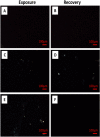The synergetic effects of 4-nonylphenol and polyethylene microplastics in Cyprinus carpio juveniles using blood biomarkers
- PMID: 37468510
- PMCID: PMC10356929
- DOI: 10.1038/s41598-023-38636-2
The synergetic effects of 4-nonylphenol and polyethylene microplastics in Cyprinus carpio juveniles using blood biomarkers
Abstract
Microplastics are widely distributed in aquatic ecosystems along with other chemical pollutants. Therefore, it is vital to study the health-hazardous effects of MPs in combination with 4-nonylphenol (4-NP), which is a highly abundant industrial waste and a critical alkylphenol endocrine disruptor. We investigated the effects of the exposure to polyethylene microplastics (PE-MPs), 4-NP, and their combination on blood biomarkers in Cyprinus carpio juveniles. Four study groups were treated for 15 consecutive days: (1) control group, (2) 10 mg/L PE-MP group, (3) 10 mg/L PE-MPs + 200 µg/L 4-NP group, and (4) 200 µg/L 4-NP group, followed by 15 days of recovery. Biochemical analyses showed that creatine kinase, lactate dehydrogenase, glucose, liver enzymes, total protein, and A/G ratios were significantly increased after exposure to PE-MPs, 4-NP, and the combination. Hematological parameters (RBC's, Hb, Ht, neutrophil percentage, and WBC's) were significantly decreased in the three exposure groups, whereas mean corpuscular volume and lymphocyte percentages were significantly increased. The 15-day recovery period improved most hematobiochemical parameters and PE-MP accumulation indices. Taken together, we demonstrated the hazardous effects of PE-MP and 4-NP combinations on C. carpio blood parameters and highlighted their potential risk to human health.
© 2023. The Author(s).
Conflict of interest statement
The authors declare no competing interests.
Figures






References
-
- PlasticsEurope. Plastics – the Facts 2018 An analysis of European plastics production, demand and waste data. 60 (2018).
Publication types
MeSH terms
Substances
LinkOut - more resources
Full Text Sources
Miscellaneous

